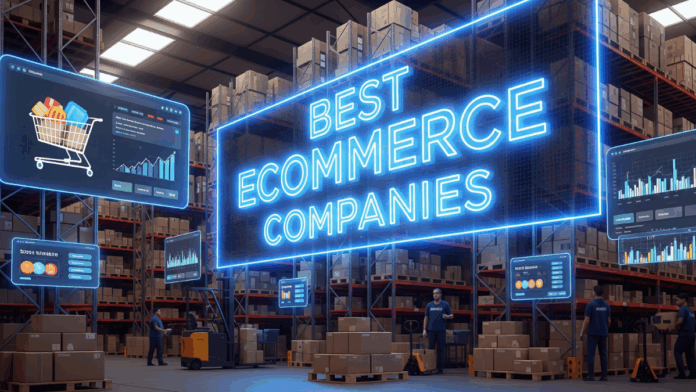The rise of digital ecommerce in India has revolutionized everything from offline to online. It has vastly changed the shopping behaviour of Indian people. The transition contributed to increased demand for products and allowed customers to make bold purchasing decisions online. Furthermore, brands have started emphasizing quick order deliveries to meet the expectations of their customers. The Indian ecommerce industry quickly became a digital shopping hub. It has experienced several international brands grow and serve the Indian consumers.
Best ecommerce companies like Amazon, eBay, to Walmart have found a huge audience set here. Local entrepreneurs had a great opportunity to showcase their unique set of products in the form of startups. The emergence of online retail and online fashion offers a great opportunity for lifestyle products, beauty products, home essentials, and even healthcare products. The tools, like sales channels and payment gateways, have benefited strategic partnerships, digital marketing, and small businesses to increase their reach across the nation. In this article, we will discuss the best ecommerce companies that contributed to the growth of the e-commerce industry in India.
What is an Ecommerce Platform?
An ecommerce platform specializes in selling products and services online. They connect the audience, manage products, and enable transactions via internet connection. Ecommerce sites house small, medium, and large businesses with a selection of products. Generally, there are four types of ecommerce businesses:
Business-to-business: The businesses that sell goods and services to other brands, like Alibaba or Shopify
Business-to-consumer: The B2C model is adopted by businesses that sell products to people directly. For example, Amazon and Zomato
Consumer to business: This model allows individual customers to sell products or services to businesses like Airbnb and Upwork.
Consumer to consumer: In this model, customers sell their products to other customers on a platform. For example, the Etsy brand adopts a C2C model.
Best Ecommerce Companies in India
| Company | Key features | Ratings |
| Amazon India | Wider variety of products
Faster delivery Strong customer support service Sophisticated search and recommendation system |
4.5/5 |
| Flipkart | Large variety of products
Exclusive deals and sales Reliable delivery service Easy-to-use application |
4.4/5 |
| Nykaa | Specializes in beauty and cosmetics
Authentic products Expert reviews and tutorials Luxury brands and collaborations |
4.6/5 |
| IndiaMart | B2B marketplace engaging customers with suppliers.
A large variety of industrial products Verified supplier list Personalized sourcing options |
4.3/5 |
| FirstCry | Specializes in baby and kids’ products
Large volume of toys, clothing, and other essentials Parenting needs and community Competitive costs |
4.5/5 |
| AJIO | Fashionable items and clothing
Exclusive brands and designer collabs Easy returns and exchanges Tailored shopping experience |
4.4/5 |
| Snapdeal | Wider product categories
Competitive pricing and discounts Seller-friendly ecommerce Regular deals and sales |
3.8/5 |
| Myntra | Competitive fashion ecommerce
Great selection of clothing, accessories, and footwear Exclusive brand partnerships Personalized recommendations |
4.5/5 |
| Purplle | Specializes in beauty and personal care products
Product reviews and ratings Deals and freebies Easy navigation and search |
4.4/5 |
Latest Articles:
AI Marketing Tools: Why 2025 Rocks the Digital World?
Luxury Brands and The Future That Lies Ahead 2025
Major Trends Shaping the Future of the Ecommerce Industry
The Indian ecommerce sector has positively grown every year. The future seems promising as more and more brands are participating in its thriving online market. Some of the trends that continue to shape the ecommerce growth in India include:
Huge Market Growth
Based on the India Brand Equity Foundation (IBEF), the substantial growth of the Indian ecommerce market is expected. It is expected to reach $325 billion by 2030. Also, the third-party logistics firms may experience 17 billion shipments in the upcoming years. Ecommerce business development services can also help in this.
Mobile Commerce
With the improvements and innovations in the ecommerce industry, more retailers are expected to continue to adopt mobile-first designs with the help of tools. They will move towards augmented reality, mobile-friendly payment approaches, and features to drive engagement among the audiences. Through m-commerce, the brands can also nurture personalized shopping and delivery experiences for the customers.
Social Commerce Boom
Retailers have found ways to sell directly to the consumers who spend a longer time on the internet. They apply different formats to serve the growing demand for online products in India. A report by Sequoia and Bain & Company revealed that the social commerce market will reach $70 billion by 2030. This means that factors like trust, engagement, and convenience drive customer demand.
Rural Market Expansion
The rural market of India has contributed largely to the growth of the Indian ecommerce industry. It has contributed to the rising number of internet users and job opportunities. It has been found that the majority of sales came from Tier 1 and Tier 2 cities last year during Diwali. This suggests that the future of Indian ecommerce will see great sales from the rural and regional areas.
Artificial Intelligence and Automation
AI and automation will continue to have an impact on the e-commerce industry. They will remain relevant to the sectors and continue helping brands find customers’ needs and their behaviour through predictive analytics. The organizations can serve their audiences more quickly and effectively with logistics automation. The technology can reduce the delivery times, inform consumers regarding their orders, and satisfy them.
Voice and Visual Search
Ecommerce businesses are adapting to voice and visual search services to make shopping easier and convenient. Customers can easily use voice-integrated devices to search for products. Hence, they can multitask and buy goods while doing other work. Voice and visual search also help the customers check and find the product before actually buying it. Also, people with disabilities can use this service to easily purchase. To offer the best services, you can use tools.
Direct-to-Consumer Growth
Direct-to-consumer is an ecommerce business model that facilitates the selling of goods directly to customers. These businesses make a great difference in the Indian ecommerce landscape with their reach to local markets and tapping into the regional niche. The D2C market is growing without any intermediaries and considering the customer preferences on its own.
Logistics and Last-Mile Delivery
Logistics and last-mile delivery are important parts of Indian ecommerce. Potential last-mile delivery partners and logistics providers serve the immediate needs of customers through an on-time delivery facility. To improve efficiency, the best ecommerce companies are using drones, smart tracking systems, electric cars, and augmented reality. These advanced technologies allow Indian ecommerce companies to look forward and become a game-changer.
Sustainability in Ecommerce
Best ecommerce companies also focus on eco-friendly initiatives and sustainability. For instance, ecommerce companies are making efforts to reduce carbon emissions from their business operations. They make efforts to promote the use of eco-friendly materials, reduce packaging waste, and use renewable energy to operate warehouses and manufacturing units.
Buy Now, Pay Later
The BNPL service is now trending in the e-commerce industry. Retailers are helping people make sensible decisions while making purchasing decisions. This helps more customers to become flexible and control their finances. The solution is converting first-time customers into loyal customers. BNPL is also contributing to the increasing sales and convenience for customers.
Final Thoughts
The future of the Indian ecommerce market seems bright with flourishing businesses and the best ecommerce companies with great customer bases. In the contemporary world, businesses are increasing their efforts to understand the pain points of customers and aligning their objectives with Artificial Intelligence and automation.


